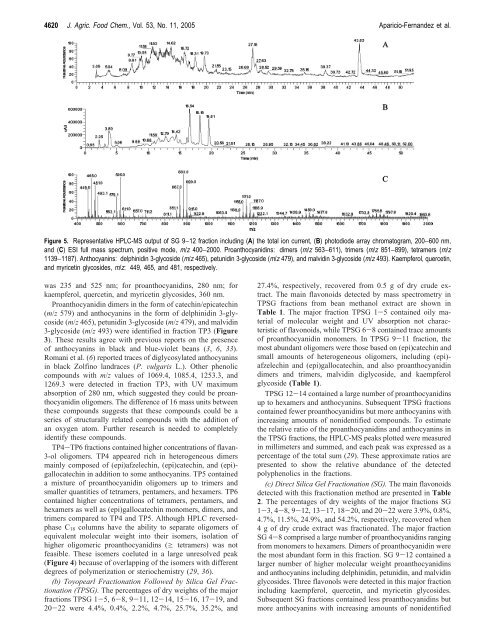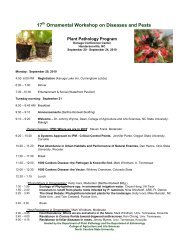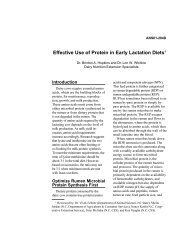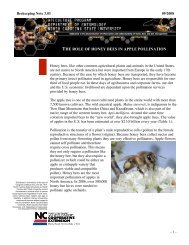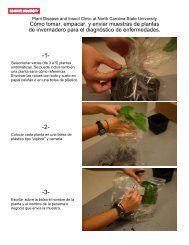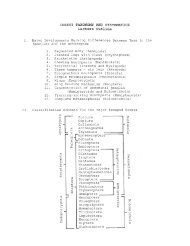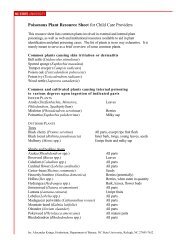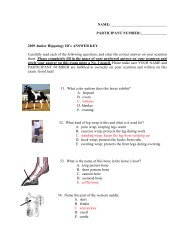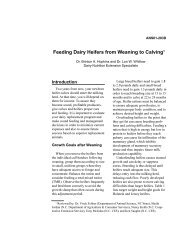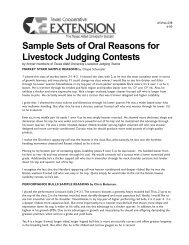Jamapa Bean (Phaseolus vulgaris L.)
Jamapa Bean (Phaseolus vulgaris L.)
Jamapa Bean (Phaseolus vulgaris L.)
You also want an ePaper? Increase the reach of your titles
YUMPU automatically turns print PDFs into web optimized ePapers that Google loves.
4620 J. Agric. Food Chem., Vol. 53, No. 11, 2005 Aparicio-Fernandez et al.<br />
Figure 5. Representative HPLC-MS output of SG 9−12 fraction including (A) the total ion current, (B) photodiode array chromatogram, 200−600 nm,<br />
and (C) ESI full mass spectrum, positive mode, m/z 400−2000. Proanthocyanidins: dimers (m/z 563−611), trimers (m/z 851−899), tetramers (m/z<br />
1139−1187). Anthocyanins: delphinidin 3-glycoside (m/z 465), petunidin 3-glycoside (m/z 479), and malvidin 3-glycoside (m/z 493). Kaempferol, quercetin,<br />
and myricetin glycosides, m/z: 449, 465, and 481, respectively.<br />
was 235 and 525 nm; for proanthocyanidins, 280 nm; for<br />
kaempferol, quercetin, and myricetin glycosides, 360 nm.<br />
Proanthocyanidin dimers in the form of catechin/epicatechin<br />
(m/z 579) and anthocyanins in the form of delphinidin 3-glycoside<br />
(m/z 465), petunidin 3-glycoside (m/z 479), and malvidin<br />
3-glycoside (m/z 493) were identified in fraction TP3 (Figure<br />
3). These results agree with previous reports on the presence<br />
of anthocyanins in black and blue-violet beans (3, 6, 33).<br />
Romani et al. (6) reported traces of diglycosylated anthocyanins<br />
in black Zolfino landraces (P. Vulgaris L.). Other phenolic<br />
compounds with m/z values of 1069.4, 1085.4, 1253.3, and<br />
1269.3 were detected in fraction TP3, with UV maximum<br />
absorption of 280 nm, which suggested they could be proanthocyanidin<br />
oligomers. The difference of 16 mass units between<br />
these compounds suggests that these compounds could be a<br />
series of structurally related compounds with the addition of<br />
an oxygen atom. Further research is needed to completely<br />
identify these compounds.<br />
TP4-TP6 fractions contained higher concentrations of flavan-<br />
3-ol oligomers. TP4 appeared rich in heterogeneous dimers<br />
mainly composed of (epi)afzelechin, (epi)catechin, and (epi)gallocatechin<br />
in addition to some anthocyanins. TP5 contained<br />
a mixture of proanthocyanidin oligomers up to trimers and<br />
smaller quantities of tetramers, pentamers, and hexamers. TP6<br />
contained higher concentrations of tetramers, pentamers, and<br />
hexamers as well as (epi)gallocatechin monomers, dimers, and<br />
trimers compared to TP4 and TP5. Although HPLC reversedphase<br />
C18 columns have the ability to separate oligomers of<br />
equivalent molecular weight into their isomers, isolation of<br />
higher oligomeric proanthocyanidins (g tetramers) was not<br />
feasible. These isomers coeluted in a large unresolved peak<br />
(Figure 4) because of overlapping of the isomers with different<br />
degrees of polymerization or steriochemistry (29, 36).<br />
(b) Toyopearl Fractionation Followed by Silica Gel Fractionation<br />
(TPSG). The percentages of dry weights of the major<br />
fractions TPSG 1-5, 6-8, 9-11, 12-14, 15-16, 17-19, and<br />
20-22 were 4.4%, 0.4%, 2.2%, 4.7%, 25.7%, 35.2%, and<br />
27.4%, respectively, recovered from 0.5 g of dry crude extract.<br />
The main flavonoids detected by mass spectrometry in<br />
TPSG fractions from bean methanol extract are shown in<br />
Table 1. The major fraction TPSG 1-5 contained oily material<br />
of molecular weight and UV absorption not characteristic<br />
of flavonoids, while TPSG 6-8 contained trace amounts<br />
of proanthocyanidin monomers. In TPSG 9-11 fraction, the<br />
most abundant oligomers were those based on (epi)catechin and<br />
small amounts of heterogeneous oligomers, including (epi)afzelechin<br />
and (epi)gallocatechin, and also proanthocyanidin<br />
dimers and trimers, malvidin diglycoside, and kaempferol<br />
glycoside (Table 1).<br />
TPSG 12-14 contained a large number of proanthocyanidins<br />
up to hexamers and anthocyanins. Subsequent TPSG fractions<br />
contained fewer proanthocyanidins but more anthocyanins with<br />
increasing amounts of nonidentified compounds. To estimate<br />
the relative ratio of the proanthocyanidins and anthocyanins in<br />
the TPSG fractions, the HPLC-MS peaks plotted were measured<br />
in millimeters and summed, and each peak was expressed as a<br />
percentage of the total sum (29). These approximate ratios are<br />
presented to show the relative abundance of the detected<br />
polyphenolics in the fractions.<br />
(c) Direct Silica Gel Fractionation (SG). The main flavonoids<br />
detected with this fractionation method are presented in Table<br />
2. The percentages of dry weights of the major fractions SG<br />
1-3, 4-8, 9-12, 13-17, 18-20, and 20-22 were 3.9%, 0.8%,<br />
4.7%, 11.5%, 24.9%, and 54.2%, respectively, recovered when<br />
4 g of dry crude extract was fractionated. The major fraction<br />
SG 4-8 comprised a large number of proanthocyanidins ranging<br />
from monomers to hexamers. Dimers of proanthocyanidin were<br />
the most abundant form in this fraction. SG 9-12 contained a<br />
larger number of higher molecular weight proanthocyanidins<br />
and anthocyanins including delphinidin, petunidin, and malvidin<br />
glycosides. Three flavonols were detected in this major fraction<br />
including kaempferol, quercetin, and myricetin glycosides.<br />
Subsequent SG fractions contained less proanthocyanidins but<br />
more anthocyanins with increasing amounts of nonidentified


